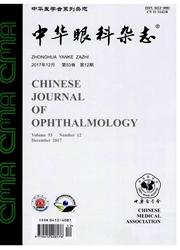

 中文摘要:
中文摘要:
目的比较一种优化的基于MRI测量视神经蛛网膜下腔间隙截面积的方法(新方法)与传统方法的可重复性。方法横断面研究。针对目前利用MRI检测视神经蛛网膜下腔间隙方法存在的不足进行优化,2016年3月至10月招募健康志愿者10名(20只眼),对眼球后3、9、15mm的垂直视神经截面进行两次MRI扫描,间隔时间1周,每次扫描分别用新方法和已报道方法获得图像,所得图像由两名经过培训的眼科医师进行后处理。优质图像获取率的组间比较采用配对卡方检验,球后不同位置的组间差异采用重复测量数据的方差分析,分别计算两种方法两测量者间的类内相关系数(ICC)比较操作者间的重复性,计算测量者A两方法前后两次扫描所得结果的ICC比较时间重复性。结果纳入的10名健康志愿者平均年龄(43.8±13.1)岁,男女比1:1,新方法在球后3、9、15mm的优质图像的获取率(100%,83%,78%)明显高于传统方法(80%,78%,70%),在球后3mill处差异有统计学意义(P=0.005);将10名(20只眼)新方法和传统方法所得的不同位置视神经蛛网膜下腔间隙截面积进行比较,发现新方法所得结果[[7.2±1.8)、(6.1±1.8)、(5.9±1.4)mm。]比传统方法所得结果f(9.0±2.9)、(7.6±2.4)、(7.1±1.6)mm。1小,在球后9mm(F=4.30,P=0.048)和15mm(F=5.67,P=0.026)处差异有统计学意义;新方法3个位置两次扫描间的ICC(0.879,0.857,0.857)高于传统方法(0.741,0.762,0.639);新方法两测量者问的ICC(0.864,0.890,0.894)高于传统方法(0.785,0.609,0.753)。结论优化的基于MRI测量视神经蛛网膜下腔间隙截面积的方法可以获得视神经的垂直截面,优质图像获取率高,测量视神经垂直截面的可重复性优于传统方法。
 英文摘要:
英文摘要:
Objective To optimize the method of acquiring the ONSAS parameter and to access the repeatability of the new method comparing with the traditional one.Methods This is a cross-sectional study. Standard operation procedure of an optimized method of acquiring the ONSAS sectional area was made against the defect of the traditional method. Ten healthy volunteers (20 eyes) in different ages were recruited from March 2016 to October. Two times of MRI scan were proceeded with the interval of one week. The optimized and traditional methods were both applied for each scanning. The images were analyzed by two ophthalmologists. The rate of high quality images between two groups was compared with matching chi-square test. The orbital subarachnoid space areas between groups at different locations were compared using analysis of variance of repeated measurement data. The ICC between different scans and different ophthalmologists was calculated. Results The mean age of the volunteers was 43.8+ 13.1 years old. Male/ Female was 1 : 1. The rates of high quality images from the optimized method (100%, 83%, 78%) was higher than those of the traditional method(80%, 78%, 70%). The orbital subarachnoid space area at 3 mm, 9 mm and 15 mm behind the eye ball acquired from the new method(7.2± 1.8, 6.1± 1.8, 5.9+ 1.4 mm^2) were bigger than those of the traditional method (9.0±2.9, 7.6±2.4, 7.1± 1.6 mm^2). Statistical significances were found at 9 mm(F=4.30, P=0.048) and 15 mm(F=5.67, P=0.026) behind the eye ball. The ICC between two different scans (0.879, 0.857, 0.857 vs 0.741, 0.762, 0.639) and two different ophthalmologists (0.864, 0.890, 0.894 vs 0.785, 0.609, 0.753) were higher in the new method group than in the traditional method group. conclusions The optimized method of acquiring the parameters of optic nerve subarachnoid space is easier to get the sectional cross area. The measuring reproducibility is better than the traditional one.
 同期刊论文项目
同期刊论文项目
 同项目期刊论文
同项目期刊论文
 期刊信息
期刊信息
